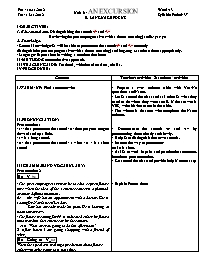Giáo án English 10 - Unit 6: An Excursion - Lesson 5: E.Language Focus - Năm học 2012-2013

I/ OBJECTIVES :
1. Educational aim: Distinguishing the sounds // and /3:/
Reviewing the present progressive (with a future meaning) and be going to
2. Knowledge:
- General knowledge: Ss will be able to pronounce the sounds// and /3:/ correctly
distinguish the present progressive (with a future meaning) and be going to and use them appropriately.
- Language: Expressions in writing a confirmation letter
II/ METHOD: Communicative approach.
III/ TEACHING AIDS: Textbook, whiteboard markers, chalks.
IV/ PROCEDURE:
Bạn đang xem tài liệu "Giáo án English 10 - Unit 6: An Excursion - Lesson 5: E.Language Focus - Năm học 2012-2013", để tải tài liệu gốc về máy bạn click vào nút DOWNLOAD ở trên
Pre : 10.11.2012 Tea: 15.11.2012 Unit 6 : AN EXCURSION E. LANGUAGE FOCUS Week: 13 Syllable Period: 37 I/ OBJECTIVES : 1. Educational aim: Distinguishing the sounds /¶/ and /3:/ Reviewing the present progressive (with a future meaning) and be going to 2. Knowledge: - General knowledge: Ss will be able to pronounce the sounds/¶/ and /3:/ correctly distinguish the present progressive (with a future meaning) and be going to and use them appropriately. - Language: Expressions in writing a confirmation letter II/ METHOD: Communicative approach. III/ TEACHING AIDS: Textbook, whiteboard markers, chalks. IV/ PROCEDURE: Contents Teacher/s activities & students/ activities I. WARM- UP: Find someone who II. PRONUNCIATION: Presentation 1 / з: / first pronounce the sound / ə / then put your tongue forward and up a little. / з :/ is a long sound. / ə / first pronounce the sound / з :/ but / ə / is a short sound IIIGRAMMAR AND VOCABULARY: Presentation 2 Be + V_ing - The present progressive may be used to express future time when the idea of the sentence concerns a planned event or definite intention. Ex: + My wife has an appointment with a doctor. She is seeing Dr. North next Tuesday. + Sam has already made his plan. He is leaving at noon tomorrow. - The future meaning for PP is indicated either by future time words in the sentence or by the context. + c) A: What are you going to do this afternoon? B: After lunch I am going shopping with a friend of mine. Be + Going to + V_inf When the speaker is making a prediction about future, either will or be going to is possible. There is no difference in meaning between (a) and (b) + (a) According to the weather report, it will be cloudy tomorrow. (b) According to the weather report, it is going to be cloudy tomorrow. (Going to expresses an intention or decision thought about before the moment of speaking. It expresses a plan) Ex: +We're going to have a holiday in Sam Son this summer. Practice 1: * Expected answer: 1) are you doing 2) is getting married 3) are you going to 4) am going to be 5) is going to Pratice 2: * Expected answer: 1) are going 2) are having 3) is going to catch 4) are you putting 5) is not going to give Pratice 3: * Answers: 1. There/s a football match on TV this afternoon. Are you going to see it? No, I’m busy. I’m doing my homework. 2. Can you come next weekend? Sorry, we’d love to, but we are visiting our grandparents. 3. I hear Tim has won a lot of money. What is he going to do with it? He says he’s going to buy a new motorbike. 4. Should I leave the umbrella at home? It/s cloudy and windy. It’s going to rain soon. 5. Do you think the windows so dirty? Oh, yes. I’m going to clean them later. - Prepare a two- column table with Yes/No questions and Name. - Let Ss around the class and ask other Ss what they used to do when they were small. If the answer is YES, write his/her name in the table. - The winner is first one who completes the Name column. - Demonstrate the sounds /ə/ and /з:/ by pronouncing them clearly and slowly. - Help Ss to distinguish these two sounds. - Instruct the way to pronounce: make is short. - Ask Ss to work in pairs and practice the sentences. Introduce peer correction. - Go around the class and provide help if necessary. - Explain Future forms - Ss listen & take notes - Ask Ss to do exercise 2: Choose the correct option in bracket. - Have Ss compare and discuss the answers with a friend. - Call on some Ss to read and explain their answers in front of the class. - Feedback and give correct answers: - Let Ss further practice using the present progressive and be going to by asking them to do exercise 2: Put the verbs in brackets in the present progressive and be going to. - Ask Ss to compare their answers with a friend. Check the exercise 2 in front of the class as a whole. - Ask Ss to do exercise 3 in pairs: Complete the exchanges, using the present progressive or be going to. - Call on some pairs to act out the exchanges in of the class. - Make necessary corrections: - Give correct answers : 4. Consolidation: Summaries the main points. 5. Homework: Assign homework
Tài liệu đính kèm:
 E.LAnguage focus.doc
E.LAnguage focus.doc





